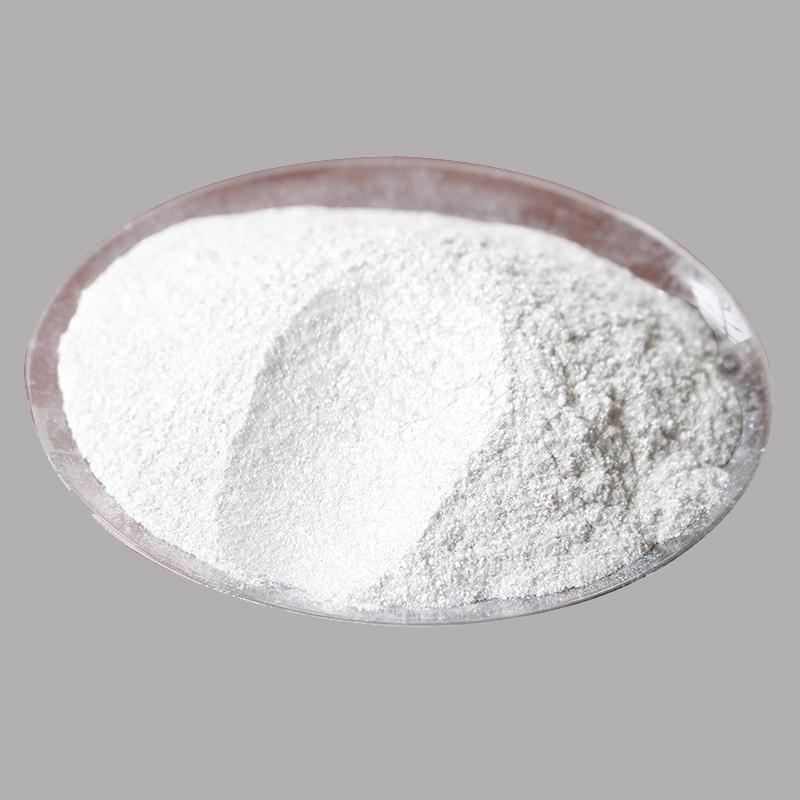AzaconazoleChemical name:1-[[2-(2,4-dichlorophenyl)-1,3-dioxolan-2-yl]methyl]-1,2,4-triazole Molecular formula: C12H11Cl2N3O2Structural formula:Molecular weight: 300.1406CAS No. : 60207-31-0Physical and chemical properties:Density: 1.51 g/cm3Melting point: DHS 112.6 CBoiling point: 460.7ºC at 760 mmHgFlash: DHS 232.4 CRefractive index: 1.658Storage conditions: 0-6ºC
Contacter maintenant
Common name: TebuconazoleChemical name:1-(4-Chlorophenyl)-4,4-dimethyl-3-(1,2,4-triazole-1-yl-methyl)pentane-3-olMolecular formula: C16H22ClN3OStructural formula: Molecular weight: 307.82CAS No. : 80443-41-0Product description:Tebuconazole is a kind of high efficiency, broad spectrum, internal absorption triazole bactericidal pesticide, with three functions of protection, treatment, eradication, wide bactericidal spectrum, long duration of efficacy. It was found that tebuconazole, like all triazole fungicides, could inhibit the biosynthesis of ergosterol from fungicide.
Contacter maintenant
Common name: AzaconazoleChemical name:1-[[2-(2,4-dichlorophenyl)-1,3-dioxolan-2-yl]methyl]-1,2,4-triazole Molecular formula: C12H11Cl2N3O2Structural formula:Molecular weight: 300.1406CAS No. : 60207-31-0Physical and chemical properties:Density: 1.51 g/cm3Melting point: DHS 112.6 CBoiling point: 460.7ºC at 760 mmHgFlash: DHS 232.4 CRefractive index: 1.658Storage conditions: 0-6ºC
Contacter maintenant
Product description:Tebuconazole is a sort of high performance, large spectrum, inner absorption triazole bactericidal pesticide, with three capabilities of safety, remedy, eradication, huge bactericidal spectrum, long length of efficacy. it became located that tebuconazole, like several triazole fungicides, could inhibit the biosynthesis of ergosterol from fungicide. tebuconazole is used as seed treatment agent and foliar spray all over the global. it has a extensive bactericidal spectrum, excessive activity and long length of efficacy.
Contacter maintenant
Common name: PropiconazoleChemical name:1-[[2-(2,4-dichlorophenyl)-4-propyl-1,3-dioxolan-2-yl]methyl]-1H-1,2,4-triazoleMolecular formula: C15H17Cl2N3O2 Structural formula:Molecular weight: 342.22CAS No. : 60207-90-1Product description:Propiconazole is a triazole fungicide, also known as a DMI, or demethylation inhibiting fungicide due to its binding with and inhibiting the 14-alpha demethylase enzyme from demethylating a precursor to ergosterol.
Contacter maintenant
Common name: EpoxiconazoleChemical name:1-[[3-(2-chlorophenyl)-2-(4-fluorophenyl)oxiran-2-yl]methyl]-1,2,4-triazole Molecular formula: C17H13ClFN3OStructural formula: Molecular weight: 329.76CAS No. : 135319-73-2Product description: Epoxiconazole is a fungicide active ingredient from the class of azoles developed to protect crops. In particular, the substance inhibits the metabolism of fungi cells infesting useful plants, and thereby prevents the growth of the mycelia (fungal cells). Epoxiconazole also limits the production of conidia (mitospores).
Contacter maintenant
Product description:Difenoconazole, also referred to as oxadifenazole, is a triazole fungicide and a sterol demethylation inhibitor. it has the characteristics of high performance, wide spectrum, low toxicity, and low dosage. an incredible kind of triazole fungicides with strong systemic houses. by using inhibiting the biosynthesis of ergosterol in pathogenic cells, it destroys the structure and characteristic of pathogen cell membranes. it is used in fruit trees, chemicalbook greens, wheat, potatoes, beans, melons, and so on.
Contacter maintenant
Product description:Propiconazole is a triazole fungicide, also referred to as a dmi, or demethylation inhibiting fungicide due to its binding with and inhibiting the 14-alpha demethylase enzyme from demethylating a precursor to ergosterol. with out this demethylation step, the ergosterols are not protected into the growing fungal cellular membranes, and cellular increase is stopped.Common name: PropiconazoleChemical name:1-[[2-(2,4-dichlorophenyl)-4-propyl-1,3-dioxolan-2-yl]methyl]-1H-1,2,4-triazoleMolecular formula: C15H17Cl2N3O2 Structural formula:Molecular weight: 342.22CAS No.
Contacter maintenant
Common name: DifenoconazoleChemical name: 1-({2-[2-Chloro-4-(4-chlorophenoxy)phenyl]-4-methyl-1,3-dioxolan-2-yl}methyl)-1H-1,2,4-triazoleMolecular formula: C19H17Cl2N3O3Structural formula: Molecular weight: 406.26CAS No. : 119446-68-3Product description:Difenoconazole, also known as oxadifenazole, is a triazole fungicide and a sterol demethylation inhibitor. It has the characteristics of high efficiency, broad spectrum, low toxicity, and low dosage. An excellent variety of triazole fungicides with strong systemic properties.
Contacter maintenant
CAS: 110488-70-5MF: C21H22ClNO4MW: 387.86 Physical chemistry properties:The melting point of 125-149 ° CVapor pressure 1 x 10-6 Pa (25 °C)Sealed in dry,Room TemperatureWater solubility 50 mg L -1 (20-23 °C) Toxicity:The acute oral LD50 of rats was greater than 3900 mg/kg, the transcutaneous LD50 was greater than 2000 mg/kg, and the acute inhaled LC50 of rats was greater than 4.24 mg/L.It has no irritation to rabbit skin, slight irritation to eyes, and no sensitization to guinea pigs.No mutagenic, teratogenic and carcinogenic effects were observed under the test conditions.
Contacter maintenant
Product description:Epoxiconazole is a fungicide active element from the magnificence of azoles evolved to defend vegetation. especially, the substance inhibits the metabolism of fungi cells infesting beneficial plants, and thereby prevents the growth of the mycelia (fungal cells). epoxiconazole also limits the producing of conidia (mitospores). epoxiconazole become introduced to the marketplace thru basf se in 1993 and can be located in many products and product mixtures concentrated on a large wide form of pathogens in various plant life.
Contacter maintenant
Common name: ImazapicChemical name: 3-Pyridinecarboxylic acid, 2-[4,5-dihydro-4-methyl-4-(1-methylethyl)-5-oxo- 1H-imidazol-2-yl]-5-methyl-Molecular formula: C14H17N3O3Structural formula:Molecular weight: 275.3CAS No. : 104098-48-8Product description:Imazapic is a sulfonylurea systemic conduction typepost-emergence selective herbicide. After the stems and leaves are treated, they can be absorbed by the stems, leaves and roots of weeds.
Contacter maintenant
Product description:it can kill mites and bugs, but now not eggs. the mechanism of movement is different from the overall insecticide is to intrude with neurophysiological sports, stimulate the discharge of γ -aminobutyric acid, and aminobutyric acid on arthropod nerve conduction inhibition. person mites, nymphs and insect larvae display paralysis after touch with avermectin, do not circulate or feed, and die in 2 ~ 4 days. the lethal effect of abamectin is slow as it does not cause speedy dehydration of insects.
Contacter maintenant
Common name: 2,4-DChemical name:2,4-dichlorophenoxy-acetic acid; (2,4-dichlorophenoxy)acetic acid; Acetic acid, 2-(2,4-dichlorophenoxy)-Molecular formula: C8H6Cl2O3Structural formula: Molecular weight: 221.04CAS No. : 94-75-7Physical and chemical properties:White crystals. Melting point is 138°C, boiling point is 160°C (53Pa). Soluble in organic solvents such as ethanol, acetone, ether and benzene, but insoluble in water. Rat oral LD50375mg/kg.Usage:Used as plant growth regulator, antiseptic and fresh-keeping agent. It can be used in compatibility with other disinfectants.
Contacter maintenant
Physical and chemical properties:The pure product is a white solid. m.p.230℃ (decomposition). it's miles infrequently soluble in wellknown organic solvents; its solubility in water is 1.2% at 25°c. normally made into glyphosate amine salt, consisting of isopropylamine salt, dimethylamine salt, and so on., can also be made into sodium salt. the glyphosate salt is soluble in water.Common name: GlyphosateChemical name: N-(Phosphonomethyl)glycineMolecular formula: C3H8NO5PStructural formula:Molecular weight: 169.07CAS No.
Contacter maintenant
Common name: Cyhalofop-ButylChemical name: (R)-2-[4-(4-cyano-2-fluorophenoxy)phenoxy] butyl propionateMolecular formula: C20H20FNO4Structural formula:Molecular weight: 357.38CAS No. : 122008-85-9Physical and chemical properties:White solid crystal, melting point 50℃, vapor pressure: 1.2x10-3mPa (20℃), lipophilic-hydrophilic equilibrium constant KowlogP=3.31, water solubility is 0.7ppm (pH7, 20℃).
Contacter maintenant
Common name: PrometryneChemical name:Prometryne; Uvon; 6-methylsulfanyl-2-N,4-N-di(propan-2-yl)-1,3,5-triazine-2,4-diamineMolecular formula: C10H19N5SStructural formula: Molecular weight: 241.36CAS No. : 7287-19-6Physical and chemical properties:The pure product is white crystals. m.p.118~120℃, vapor pressure 1.33×10-4Pa. It is easily soluble in organic solvents, and it dissolves Chemicalbook in water at a degree of 48mg/L at 20°C. Non-flammable, non-explosive, non-corrosive.
Contacter maintenant
Common name: MesotrioneChemical name:2-[4-(methylsulfonyl)-2-nitrobenzoyl]-1,3-cyclohexanedioneMolecular formula: C14H13NO7SStructural formula:Molecular weight: 339.32CAS No. : 104206-82-8Product description:Mesotrione is an effective inhibitor of HPPD (4-hydroxyphenylpyruvate dioxidase), which is widely present in various organisms and catalyzes the initial reaction of plastoquinone and tocopherol biosynthesis.
Contacter maintenant
Common name: IndoxacarbChemical name:reaction mass of (S)- Indoxacarb and (R)- Indoxacarb 75:25; methyl 7-chloro-2-{(methoxycarbonyl)[4-(trifluoromethoxy)phenyl]carbamoyl}-2,5-dihydroindeno[1,2-e][1,3,4]oxadiazine-4a(3H)-carboxylateMolecular formula: C22H17ClF3N3O7Structural formula:Molecular weight: 527.83CAS No.
Contacter maintenant
Common name: ImazamoxChemical name:(RS)-2-(4-isopropyl-4-methyl-5-oxo-2-imidazolin-2-yl)-5-methoxymethylnicotinic acidMolecular formula: C15H19N3O4Structural formula:Molecular weight: 305.33CAS No. : 114311-32-9 Physical and chemical properties:This product is solid. m.p.166~166.7℃, vapor pressure<1.3×10-5Pa. The solubility is: methylene chloride 14.3g/100L, methanol 6.68g/100L, acetone 2.93g/100L, acetonitrile 1.85g/100L, ethyl acetate 1.02g/100L, n-hexane 0.0006g/100L, partition coefficient 5.36 (25℃) ).
Contacter maintenant
Common name: Clodinafop-propargylChemical name:2-propynyl-(R)-2-[4-(5-chloro-3-fluoro-2-pyridyloxy)phenoxyl]-prpionateMolecular formula: C17H13ClFNO4Structural formula: Molecular weight: 349.74CAS No.
Contacter maintenant
Common name: FIPRONILChemical name: 5-amino-1-[2,6-dichloro-4-(trifluoromethyl)phenyl]-4-[(trifluoromethyl)sulfinyl]-1H-pyrazole-3-carbonitrileMolecular formula: C12H4Cl2F6N4OSStructural formula: Molecular weight: 437.15CAS No.
Contacter maintenant
Molecular formula: C4H6N2S4ZnMolecular weight: 276.7802CAS:12122-67-7 Physical property :1. Properties: off-white powder, industrial products are light yellow powder, slightly rotten egg taste, strong moisture absorption.2. Melting point (℃) : decomposition3. Relative density (water =1) : 1.74 (20℃)4. Octanol/water partition coefficient: 1.35. Solubility: insoluble in water, dissolved in carbon disulfide, pyridine, insoluble in most organic solvents. Toxicity:1. Acute toxicityLD50: > 5200mg/kg (rat oral)LC50:1850mg/m3 (rat inhalation)2. No data on irritation3.
Contacter maintenant
Common name: AlachlorChemical name: 2-chloro-N-(2,6-diethylphenyl)-N-(methoxymethyl)acetamide; Molecular formula: C14H20ClNO2Structural formula:Molecular weight: 269.77CAS No.
Contacter maintenant


































